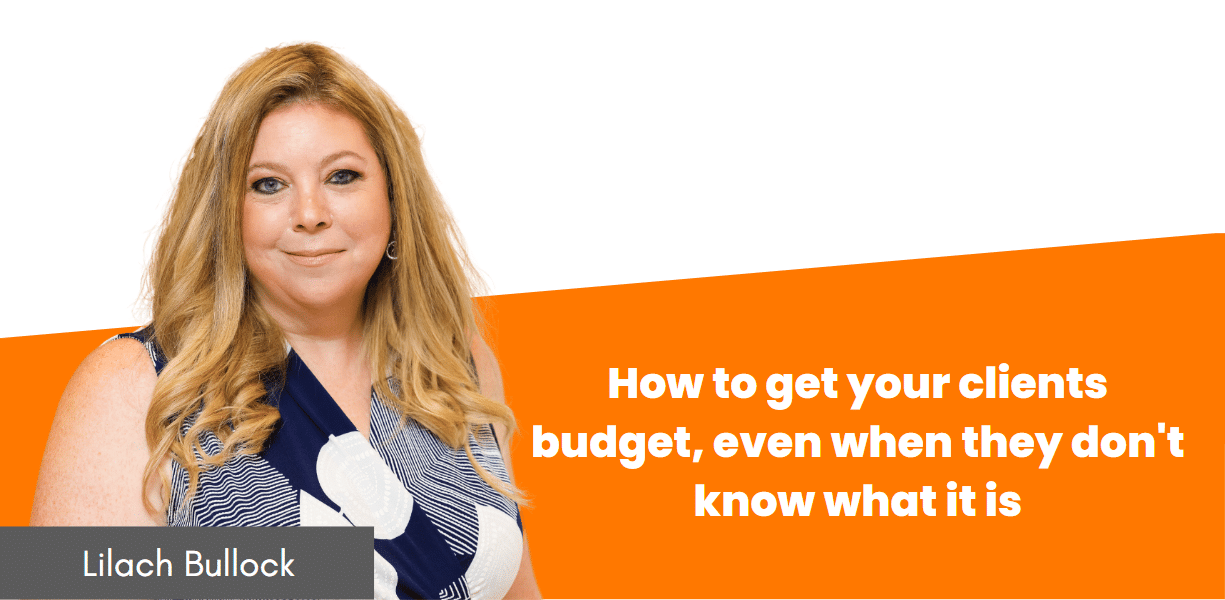Follow Lilach

How to get your clients budget, even when they don’t know what it is
Finding out how much your client is willing to spend/the client budget is a struggle faced by many entrepreneurs and businesses.
In fact, it can often be one of the toughest parts of the job; you don’t want to appear too preoccupied with your costs but you need to prepare a proposal the client can accept.
In this blog post, I am going to show you the most effective ways to work out your client’s budget, even when they are reluctant to discuss the subject.
When it comes to pricing any job there are two popular ways of approaching the subject. One way is to never discuss the budget with your client before submitting a proposal.
Stick to your standard pricing and submit a proposal in line with what you would normally charge for a project of that size. I understand the thinking behind this approach, and that it is often aimed at making sure you don’t just compete on price, but create the right solution and then present it to the client.
Despite the appeal of that approach, I believe it is serious mistake. If you have no idea what your clients budget is, you are setting yourself up for failure, and you can’t offer them the best solution for their problem.
 Understanding your client’s budget as early as possible in the discussion process is essential. You need to know what the client’s expectations are and whether you can reasonably meet them within their proposed budget constraints. It’s possible that their budget is unrealistic.
Understanding your client’s budget as early as possible in the discussion process is essential. You need to know what the client’s expectations are and whether you can reasonably meet them within their proposed budget constraints. It’s possible that their budget is unrealistic.
Some clients do have wrong expectations of what can be achieved, and others may not have properly thought through how much their project is likely to cost them.
In those cases, you need to move on and stop wasting time or find another solution that does fit the budget.
Clients are frequently reluctant to give even a ball-park figure up-front.
If you can’t determine how much they are willing to spend it becomes difficult to know how much effort you should invest in a project, and whether it is even worth your while to continue with it. Your time is worth money, and if you are spending it working on their project then you need to know that your client is willing to pay at least your standard rates.
How to get a client budget: useful tips
- Don’t be afraid to ask directly
- Let them know your rates
- Keep it friendly
- Don’t be afraid to negotiate
- Find out the value to the client
- Built trust together
Don’t be afraid to ask
Not everything has to be complicated, sometimes clients are happy to talk money without any delay.
You don’t know until you ask.
One of the biggest mistakes you can make is not asking your client about their budget for a project.
Many clients will be genuinely reluctant to discuss figures, but others are simply waiting to be asked, and it’s your job to raise the topic.
Don’t be afraid to raise the issue or assume they are holding out on you until you have actually asked them.
Let them know your rates
If the client avoids the question of a budget or seems hesitant about naming a figure there is nothing wrong with letting them know what your standard rates are, or providing them with an estimate based on your understanding of their requirements.
[click_to_tweet tweet=”How to get your clients budget, even when they don’t know what it is #sales #salestips” quote=”How to get your clients budget, even when they don’t know what it is #sales #salestips”]
Once you have asked enough questions to work out the likely costs involved, and given a price, you will be able to judge from the client’s reaction whether you both have similar expectations for the project.
You could start off saying something like:
This sounds like a straightforward job, I understand that you want X, Y, & Z features. We are going to need to work through the details to make sure we cover everything that you want, and for me to give you a detailed proposal, and completion timescale. Just so I can make sure that we are a good fit for your business, I want to let you know that my rough prices for this job is somewhere in the range of £10,000-£15,000. Is that comfortable for you?
This approach almost always gets the results I need.
If the client lets you know immediately that they were thinking of a much lower figure then you can quickly establish how much they are willing to pay.
If they suggest that the figure is a little high, but within their means then you can negotiate on exactly what they need, and maybe discuss completing the project in stages to spread the cost.
Once you have at least a rough idea of what the client is willing to pay then you are able to work out the most suitable option for their budget.
If they are asking you to build a website for them, but they are unable to afford your costs, then you could offer a range of alternative pricing, from a slimmed-down version of their original idea, through to an off-the-shelf template that will only cost a fraction of your original proposal.
Try approaching your client in this way:
I appreciate that this project is on a very tight budget. A lot of clients don’t realise the amount of work involved in designing a website. If you don’t want to pay for the bespoke site at this time there are a number of options. We could scale back the project and just include the most essential features at this stage, or you could have an existing template customised to your requirements for much less than the cost of a uniquely developed site.
By offering your client options you should be able to work out which parts of the project are essential, and which can be trimmed, and in this way determine what your clients budget is, and what they really want.
Finding out this information early will stop you from producing detailed proposals with no idea of whether they are within the scope of your client’s budget.
Shooting in the dark, and spending time drawing up proposals that are never going to be used isn’t in anyone’s interest.
Why waste your time on them when you could be doing something more productive?
Establishing at least a rough budget will help you to plan effectively. If you can produce a proposal that you know is within your client’s budget there is a much higher chance of it being successful.
What if the client really doesn't seem to know their budget?
If your client really doesn't seem to know or just won't say what their budget is there are a number of possible explanations.- They have little experience with this type of work and don't know what they should expect to pay for your services. In that situation, you have a great opportunity to educate them in your industry. You can talk them through past projects and explain the costs involved. Show them work you have done for other clients and talk them through the various stages involved. By the end of the process, you should both have a much better idea whether you will be able to work together.
- They prefer to see what you can offer before they commit themselves to a price. In this situation, it is essential that you extract the information from them in a way that is as painless as possible. You don't need to know an exact figure. A general ball-park number should be good enough. Even a client who doesn't have a fixed figure in mind will still have a price range that they are comfortable
I appreciate that you haven't finalised your budget yet. Do you think the decision will be nearer £1000, £5,000, or £15,000?Think carefully before you choose these numbers. The lowest number you pick should never be lower than a price you would be comfortable accepting.
 Try to make it as close as possible to the smallest project you can imagine the client asking for. Pitch the biggest number quite a bit higher than the largest project you can imagine them asking for. By aiming high, you may discover a few very pleasant surprises. You can't frighten off your client by mentioning high numbers as you have already given them lower choices as well.
[click_to_tweet tweet="How to get your clients budget, even when they don't know what it is #sales #salestips" quote="How to get your clients budget, even when they don't know what it is #sales #salestips"]
If you are in the same room with the client at this point watch their face for a reaction. If you happen to be on the telephone try to hear any audible reaction to these numbers.
Do they look as though they are seriously considering the higher option or did they go a little paler when you mentioned it? If they look shocked or need to sit down quickly then you probably need to think about some alternative options.
What normally happens at this point is that the prospective client will choose the number closest to what they were thinking of, and may well add some qualification to their choice.
Try to make it as close as possible to the smallest project you can imagine the client asking for. Pitch the biggest number quite a bit higher than the largest project you can imagine them asking for. By aiming high, you may discover a few very pleasant surprises. You can't frighten off your client by mentioning high numbers as you have already given them lower choices as well.
[click_to_tweet tweet="How to get your clients budget, even when they don't know what it is #sales #salestips" quote="How to get your clients budget, even when they don't know what it is #sales #salestips"]
If you are in the same room with the client at this point watch their face for a reaction. If you happen to be on the telephone try to hear any audible reaction to these numbers.
Do they look as though they are seriously considering the higher option or did they go a little paler when you mentioned it? If they look shocked or need to sit down quickly then you probably need to think about some alternative options.
What normally happens at this point is that the prospective client will choose the number closest to what they were thinking of, and may well add some qualification to their choice.
£1000 is about right, but we could go a little higher if we need toOr
£15,000 is closest, but that would be on the high side of our expectations.Once you have the ball-park figure you can try to refine the figure by coming back with different options around that figure. Always make the bigger option bigger than you think possible. You never know what may happen, your client’s budget may be far bigger than you realise.
Keep it friendly
 It is essential for the success of your financial discussions that they stay friendly. You are building a relationship, not engaging in a battle.
Explain to your client that you can offer them a range of services in, for example, the range of £1000-£5000, and you want to know what their realistic range is.
Having the discussion at this point doesn't mean that you can avoid doing due diligence, or offering your client a complete solution, but it does mean that you have a much better idea of what to offer them, and what they are most likely to accept.
The only way to effectively deliver a solution that fully meets your client’s goals and objectives is to fully grasp their expectations and what they want to achieve. If you don't know their budget you can't do that.
It is essential for the success of your financial discussions that they stay friendly. You are building a relationship, not engaging in a battle.
Explain to your client that you can offer them a range of services in, for example, the range of £1000-£5000, and you want to know what their realistic range is.
Having the discussion at this point doesn't mean that you can avoid doing due diligence, or offering your client a complete solution, but it does mean that you have a much better idea of what to offer them, and what they are most likely to accept.
The only way to effectively deliver a solution that fully meets your client’s goals and objectives is to fully grasp their expectations and what they want to achieve. If you don't know their budget you can't do that.
Don't be afraid to negotiate
If your client gives you a figure for their budget you should not necessarily assume that figure is final. Don't be afraid to negotiate with them, and identify any flexibility in their budget. Start by determining a profit margin you are happy with, and add your costs on to that. Don't be afraid to ask for what you need, if you aren't happy with what you are earning then you may as well stop right now. This isn't an opportunity to try to extort extra money for the same work, but to demonstrate how you can build extra value into the proposal for your client. Both you and the client have to be happy with the final arrangement, or the project is not going to be successful. Why not try presenting your client with a range of options for them to choose from? Some of the options will be an essential part of the project, and other parts will be optional. Following this approach lets you build up an understanding of the client’s budget by seeing which parts they want to include, and which they are happy to leave. [click_to_tweet tweet="How to get your clients budget, even when they don't know what it is #sales #salestips" quote="How to get your clients budget, even when they don't know what it is #sales #salestips"] This technique is particularly useful for avoiding clients who like to add extra elements later in a project. Sometimes you can be partway through a project and a client will ask you for some additional work, and it can be hard to say no as you have already started, especially if it is a small thing. It can feel like it doesn't matter that much. The problem is that if you agree to do something for free, it won't be long before the client is back asking for something else for free. By itemising everything in this way before you start both you and the client know exactly what to expect at every stage of the project and you can both avoid nasty surprises later on.Find out the value to the client
Some clients are on genuinely tight budgets and don't understand the costs involved in bringing their project to completion, while others may have the money but don't necessarily want to spend more than they have to on your project. The challenge can often be determining which group your current client is in and explaining to the clients why they should choose to spend the money on your services and why you are worth the money you are asking them for. This is your opportunity to demonstrate your value to the client and to prove that purchasing services from you would be a wise investment, but it is also a great opportunity for you to find out what this project is worth to the client. Try asking questions like:Why start this project now instead of in a years’ time?Or
What is the cost to your company if I don't complete this project?If you can get the client to reveal some information about what the project means to them then you will be in a much stronger position to gauge the worth of the project to them, and where you should be pitching your pricing. If you are trying to establish your own worth with the client then it can be helpful to give them some examples of projects you have been involved in and qualify the costs involved in each of them. This often gives the client reason to accept your costs or to dismiss the idea as outside their budget. If that happens at least you will no longer be wasting each other’s time. If you can demonstrate to your client why your proposal is of superior value to them it is entirely possible that you can persuade them to increase their budget. Often clients have little idea of the value of your services and select an arbitrary figure for the budget. In this situation, they may well be open to negotiation if you can show them that there is value in accepting a higher-priced proposal.
What if the client still won't reveal their budget?
If the client still won't say how much they are willing to spend. There are only two possibilities. You can cut your losses and walk away, or you can insist that they tell you. You should explain that understanding their budget is vital to developing a solution that is appropriate for their needs.Build trust together
 Finding the right solution must involve working closely with your clients if you can't work within their budget don't be afraid to recommend someone who can. The key to successful interaction with clients is building a relationship.
Sometimes asking them difficult questions is the only way to make the relationship work. If you are going to work together successfully there must be mutual trust. While budgets are vital, it is important to get beyond that.
For any project, it is the solution that is ultimately developed that is the most important aspect. You need to work with your clients to create the most effective solution for their needs.
The foundation for that solution is laid at the very start of the relationship when you establish a basis of trust with your client. If the client is unable to trust you with their budget then the services you will be offering the client aren't going to be right for them.
Establishing trust must come first.
Talk to the client, find out what they want and then give them some options. If what you suggest is outside their budget then you will be able to layout some alternative options based on their budget expectations.
Once this informal discussion is complete you can go ahead and craft a detailed proposal based on your understanding of what the client is looking for.
Working this way offers a much higher probability of success because you already know that what you are proposing is within the scope of the client’s budget.
Finding the right solution must involve working closely with your clients if you can't work within their budget don't be afraid to recommend someone who can. The key to successful interaction with clients is building a relationship.
Sometimes asking them difficult questions is the only way to make the relationship work. If you are going to work together successfully there must be mutual trust. While budgets are vital, it is important to get beyond that.
For any project, it is the solution that is ultimately developed that is the most important aspect. You need to work with your clients to create the most effective solution for their needs.
The foundation for that solution is laid at the very start of the relationship when you establish a basis of trust with your client. If the client is unable to trust you with their budget then the services you will be offering the client aren't going to be right for them.
Establishing trust must come first.
Talk to the client, find out what they want and then give them some options. If what you suggest is outside their budget then you will be able to layout some alternative options based on their budget expectations.
Once this informal discussion is complete you can go ahead and craft a detailed proposal based on your understanding of what the client is looking for.
Working this way offers a much higher probability of success because you already know that what you are proposing is within the scope of the client’s budget.
Conclusion: how to get a client budget
Finding out your client's budget isn't always easy, but it is essential if you don't want to waste time writing proposals that the client will never accept. Have any of these methods worked for you? What other tactics have you found to get clients to talk about money, even when they don't want to? If you have found this post helpful please leave a comment below, and don't forget to share :)
Follow Lilach















